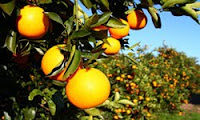The Argo Water Trailer by GEI Works
is often known for its dust suppression, firefighting, and liquid transport
capabilities. Water trailers can function on construction sites, farms, and
arenas by fitting the appropriate hose, nozzle and spray bar to a polyethylene
tank, and while the water trailer excels at these tasks, the agricultural
industry has popularized water trailers for the following seven uses:

1.
Mash spreading – Corn mash can be loaded into
our water trailers with the addition of a few modifications to the pumping
system of the water trailer. This mash can then be delivered to various
locations and used as livestock feed. Often, this makes use of a common
byproduct of distilleries.
2.
Pesticide application – Pesticides can be mixed
into the water supply in the tank then sprayed onto the applicable crops. While
there are often larger scale methods of accomplishing this, using a water
trailer offers a more flexible method of application, along with the mobility
of water transport.
3.
Odor suppression – With the use of certain organic
cleaners, Argo Water Trailers can be optimized to eliminate odors on livestock
and agricultural farms. It can be as simple as including a concentrated organic
cleaner in the water reservoir of the trailer and applying it to a designated
area.
4.
Biofertilization – As part of organic farming
methods, biofertilization of crops is on the rise. Blue-green algae
biofertilizer can pumped out of our water trailer in a similar fashion as a
hydroseeding application, then distributed onto applicable crop fields for
enriching the available nutrient levels

5.
Hydroseeding – Hydroseeding decreases erosion
and enriches the soil by distributing a mixture of seed, fertilizer, and mulch.
Often used to prevent soil erosion, hydroseeding mixtures can be applied to
fields and hillsides to prevent the erosion of cropland from water and wind.
6.
Livestock watering – Livestock watering is one
of the simplest, but most important application for Argo trailers in the
agricultural industry. Each water trailer comes standard with the capability of
containing potable drinking water and, because of its mobility, can deliver
this water to a location on-demand.

7.
Crop protection –Water trailers can be used for
crop protection in the winter. In Florida, for example, farmers will spray down
orange trees if the temperature will reach freezing that night. Crop icing isn’t
limited to just oranges, however, as mangoes, avocados, strawberries, limes,
and even corn can survive frost and freezing temperatures through the icing
process.
Read more here.
The agricultural industry is as
vast as it is varied, and GEI Works strives to meet or exceed the needs of
farmers and livestock owners. To learn more about product solutions by GEI
Works, check out our
Water Trailers, Livestock Troughs,
or
CitrusTubs.
 We’re excited to announce our new blog
series on aquatic plant control! Aquatic plants are an important part of the
ecosystem, however invasive and non-native plants can impair water systems and
impact fish and wildlife habitats, conservation efforts, marine navigation,
recreation, tourism, irrigation, energy, and drinking water.
We’re excited to announce our new blog
series on aquatic plant control! Aquatic plants are an important part of the
ecosystem, however invasive and non-native plants can impair water systems and
impact fish and wildlife habitats, conservation efforts, marine navigation,
recreation, tourism, irrigation, energy, and drinking water.


